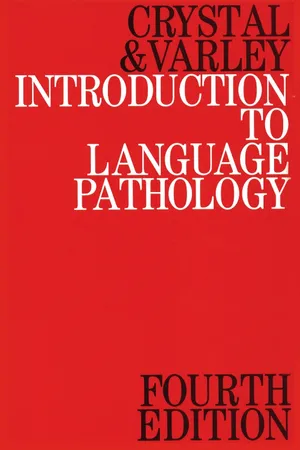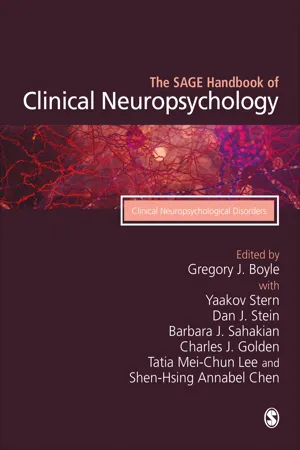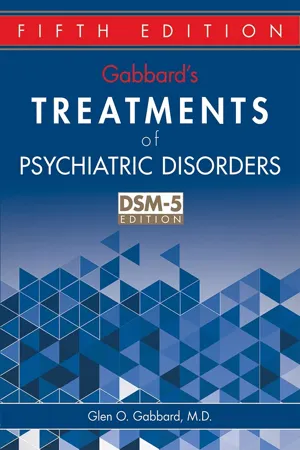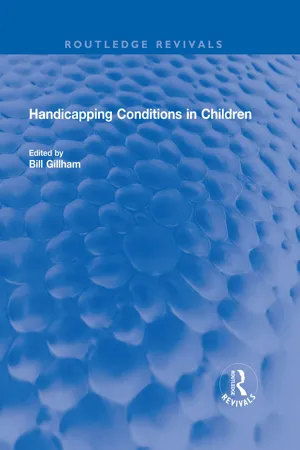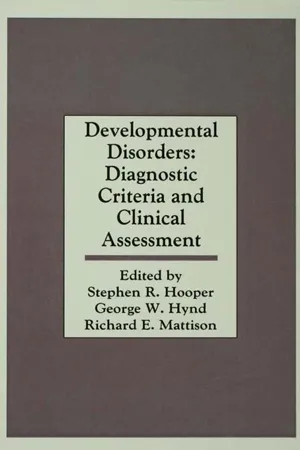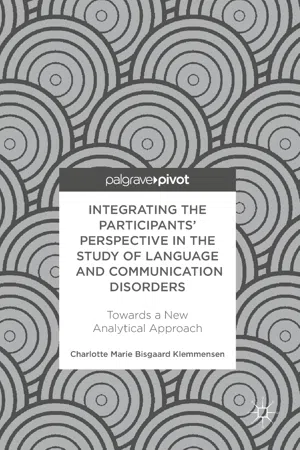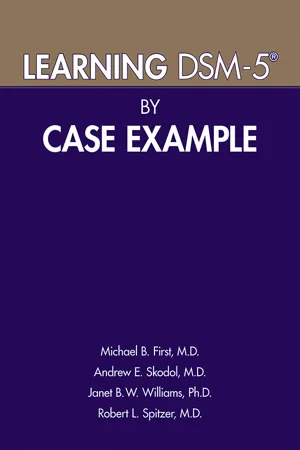Psychology
Language Disorders
Language disorders refer to difficulties in understanding and using spoken or written language. These disorders can affect various aspects of language, including grammar, vocabulary, and comprehension. They can be caused by neurological conditions, developmental delays, or environmental factors, and may impact an individual's ability to communicate effectively.
Written by Perlego with AI-assistance
Related key terms
Related key terms
1 of 4
Related key terms
1 of 3
10 Key excerpts on "Language Disorders"
- eBook - ePub
- Robin L. Hansen, Sally J. Rogers(Authors)
- 2012(Publication Date)
- American Psychiatric Association Publishing(Publisher)
PEECH AND LANGUAGE DISORDERS IN CHILDHOOD A Neurodevelopmental Perspective Ann M. Mastergeorge, Ph.D.Signs, Symptoms, and Developmental Course
In DSM-5, which is expected to replace DSM-IV-TR (American Psychiatric Association 2000 ) in 2013, speech and Language Disorders will fall under the heading of neurodevelopmental disorders, and the term Language Disorders will be used to describe language behaviors that are different from those expected for a child’s chronological age. The definition of Language Disorders by the American Speech-Language-Hearing Association is influenced primarily by Bloom and Lahey’s (1978) conceptual model of the structure of language and the domains that are affected if this structure is disrupted. A language disorder may involve one or more of the following: 1) the form of language (phonology, morphology, syntax), 2) the content of language (semantics), 3) the function or use of language in social communication (pragmatics). The various patterns emphasize that Language Disorders encompass many different kinds of disruption in the integration of content, form, and use. The term describes the conditions of children who have difficulty learning the form of language (a disruption of form), children who can talk easily and readily but who have little meaning in their communication (a disruption of content), and children who use forms to communicate ideas but not in the conventional manner (a distortion of the interactions among content, form, and use). In sum, a language disorder is an impairment in the ability to 1) receive and/or process a symbol system, 2) represent concepts or symbol systems, and/or 3) transmit or use symbol systems.Language Disorders are heterogeneous, vary in levels of severity, and are generally categorized by the type of exhibited symptoms. Children with Language Disorders typically share four common symptoms. First, children with language delays almost always show a deficiency in the quantity of language learned - eBook - ePub
- David Crystal, Rosemary Varley(Authors)
- 2013(Publication Date)
- Wiley(Publisher)
An important characteristic of Language Disorders is that their effects may appear at different points in the communication chain, and in any of the modalities of language use. The disorder may affect both language encoding and decoding – that is, the patient could have difficulties both in formulating linguistic messages and in understanding them. It is possible, however, that language encoding alone may be affected, with the ability to understand language being relatively normal; and, more rarely, that language decoding may be affected, with the ability to produce language appearing normal. In both cases, there needs to be careful assessment by the language pathologist, because comprehension disorders may go unnoticed – the patient perhaps using other sources of information to decode messages, such as the contextual or the non-verbal (see p. 82). In addition to affecting performance across input and output, Language Disorders may disrupt performances across both auditory and visual channels of language use – that is, speech/listening and reading/writing. Thus a child with a language disorder may have difficulties in creating grammatical sentences in speech, and problems of a similar order may also be observed in writing. Pre-school children with Language Disorders may also go on to have difficulties in learning to read and write.Different degrees of involvement of the four channels of language use result in one patient potentially being very different from another. Language disorder is not a homogenous category. Not only are there differences in performance across modalities; patients may also differ in the type of difficulty they have within modalities, such as when formulating a spoken message. One patient may have particular difficulty in producing a grammatical sentence, whereas another may have problems in finding the appropriate words for use in a sentence. The language pathologist might describe the first patient’s difficulty as one of grammatical encoding, and the second as one of semantic or lexical encoding. Any of the levels of language organization that were identified in Chapter 2 – grammar, semantics, phonology and pragmatics – may be affected, and to varying degrees. The language pathologist must therefore have considerable skill in performing linguistic analyses in order to be able to pinpoint areas of deficit in the patient’s linguistic knowledge and performance. During the 1970s, several important developments in the analytical study of language disability took place within the range of disciplines categorized as ‘behavioural’ (p. 30). The application of ideas from the fields of psychology and linguistics have, as a result, shaped present-day perceptions of language disability. - eBook - ePub
The SAGE Handbook of Clinical Neuropsychology
Clinical Neuropsychological Disorders
- Gregory J. Boyle, Yaakov Stern, Dan J. Stein, Barbara J. Sahakian, Charles J. Golden, Tatia Mei-Chun Lee, Shen-Hsing Annabel Chen, Gregory J. Boyle, Yaakov Stern, Dan J. Stein, Barbara J. Sahakian, Charles J. Golden, Tatia Mei-Chun Lee, Shen-Hsing Annabel Chen(Authors)
- 2023(Publication Date)
- SAGE Publications Ltd(Publisher)
(2017) have important implications for ensuring that definitions are applied consistently across the field, given that the lack of consensus in terminology to date has impeded diagnosis and treatment of Language Disorders, and limited relevant research. In this chapter, we refer to the constellation of significant language-related challenges as language disorder. This label, mirroring that of the DSM-5, is the terminology to which a clinical neuropsychologist may have the most exposure in undertaking diagnostic assessment. Prevalence Estimates of language disorder vary somewhat depending on methodological differences, including diverse labelling practices and group membership inclusion criteria. Language disorder is widely regarded as a fairly common condition associated with significant functional impairment, such that the child's academic performance, social interactions, or effective communication is impacted (Bishop et al., 2017). This functional impairment can continue into adulthood (Whitehouse et al., 2009). Prevalence typically hovers at 7 percent in the general population, with males more often affected than females at a ratio of about 4:3 (Norbury et al., 2016). Language disorder also appears to be heritable to many cases (Conti-Ramsden et al., 2007). Several genes implicated in memory as well as the motor production of speech have been associated with language disorder risk. Other genetic factors as well as environmental influences are posited to impact the risk and expression of clinical language impairments, though less is known about what these factors are and how they interact with identified risk genes (Newbury et al., 2010). Developmental Trajectories Language production and acquisition follow a typical developmental trajectory. Toddlerhood encompasses a period of rapid cognitive, language and socio-emotional development (National Research Council, 2000) - eBook - ePub
Neurodevelopmental Disorders
DSM-5® Selections
- (Author)
- 2015(Publication Date)
- American Psychiatric Association Publishing(Publisher)
B. Language abilities are substantially and quantifiably below those expected for age, resulting in functional limitations in effective communication, social participation, academic achievement, or occupational performance, individually or in any combination.C. Onset of symptoms is in the early developmental period.D. The difficulties are not attributable to hearing or other sensory impairment, motor dysfunction, or another medical or neurological condition and are not better explained by intellectual disability (intellectual developmental disorder) or global developmental delay.Diagnostic Features
The core diagnostic features of language disorder are difficulties in the acquisition and use of language due to deficits in the comprehension or production of vocabulary, sentence structure, and discourse. The language deficits are evident in spoken communication, written communication, or sign language. Language learning and use is dependent on both receptive and expressive skills. Expressive ability refers to the production of vocal, gestural, or verbal signals, while receptive ability refers to the process of receiving and comprehending language messages. Language skills need to be assessed in both expressive and receptive modalities as these may differ in severity. For example, an individual’s expressive language may be severely impaired, while his receptive language is hardly impaired at all.Language disorder usually affects vocabulary and grammar, and these effects then limit the capacity for discourse. The child’s first words and phrases are likely to be delayed in onset; vocabulary size is smaller and less varied than expected; and sentences are shorter and less complex with grammatical errors, especially in past tense. Deficits in comprehension of language are frequently underestimated, as children may be good at using context to infer meaning. There may be word-finding problems, impoverished verbal definitions, or poor understanding of synonyms, multiple meanings, or word play appropriate for age and culture. Problems with remembering new words and sentences are manifested by difficulties following instructions of increasing length, difficulties rehearsing strings of verbal information (e.g., remembering a phone number or a shopping list), and difficulties remembering novel sound sequences, a skill that may be important for learning new words. Difficulties with discourse are shown by a reduced ability to provide adequate information about the key events and to narrate a coherent story. - eBook - ePub
- Glen O. Gabbard(Author)
- 2014(Publication Date)
- American Psychiatric Association(Publisher)
The mental health clinician’s role should remain integral in the overall treatment of communication disorders. Assessment and treatment of comorbid psychiatric conditions are critical to the overall success of any interventions for speech and Language Disorders. The mental health clinician can also provide an educational and supportive role for parent and child. Importantly, the mental health clinician acts as a liaison between the educational system, family, and other treatment providers to assist in planning the child’s individualized education program (IEP) and in determining proper classroom interventions and placement (American Academy of Child and Adolescent Psychiatry 1998).Specific Disorders
Language Disorder
Language Disorders are currently conceptualized in the literature using multiple classification systems. The current discussion will present the information concerning treatment based on the domains of language development, expression, and understanding/comprehension (reception). DSM-5 has established language disorder as a single diagnostic category to identify children with persistent 25 difficulties in the acquisition and use of language (language delay) with evident deficits in production (expression) and comprehension (reception) functions (Box 2–1 ).Box 2–1. DSM-5 Diagnostic Criteria for Language Disorder315.32 (F80.2)A. Persistent difficulties in the acquisition and use of language across modalities (i.e., spoken, written, sign language, or other) due to deficits in comprehension or production that include the following:1. Reduced vocabulary (word knowledge and use). 2. Limited sentence structure (ability to put words and word endings together to form sentences based on the rules of grammar and morphology). 3. Impairments in discourse (ability to use vocabulary and connect sentences to explain or describe a topic or series of events or have a conversation).B. Language abilities are substantially and quantifiably below those expected for age, resulting in functional limitations in effective communication, social participation, academic achievement, or occupational performance, individually or in any combination. - eBook - ePub
- Bill Gillham(Author)
- 2022(Publication Date)
- Routledge(Publisher)
CHAPTER 2 Disorders of Language and Communication DOI: 10.4324/9781003261964-2 BILL GILLHAMThe two milestones most eagerly awaited by the parents of a young child are the first independent steps and the first independent words. Both achievements, if they occur at around the normal time, are incontrovertible evidence that several interrelated systems of the body and brain are functioning efficiently. Of the two achievements, independent language use is the more complex neurologically and is of more direct significance for normal psychological development. It marks emerging intelligence and the development of relationships with other people.It is not surprising, therefore, that the commonest reason for a preschool child to be brought to a psychological or paediatric clinic is language delay. The great majority of such children will go on to develop language normally, without special help; they will have had a simple delay which caused temporary concern but was, self-evidently, of no particular significance. But in a minority the delay will be more enduring and may prove to be symptomatic of other conditions such as mental handicap or hearing impairment. For these reasons all language delay has to be taken seriously since it is only by careful investigation and the monitoring of progress that those children who need special attention can be identified.What is Language?
Language is most simply described as a system of symbols which we can use to represent ideas, information, wishes, intentions and the like. That much is obvious. When we use the term ‘language’ we are most commonly referring to speech — the expressive dimension. Less conspicuous, but equally important, our understanding of language (comprehension) is another part of the process. More covertly we also use language as an internal or associative - eBook - ePub
Developmental Disorders
Diagnostic Criteria and Clinical Assessment
- Stephen R. Hooper, George W. Hynd, Richard E. Mattison, Stephen R. Hooper, George W. Hynd, Richard E. Mattison, Stephen R. Hooper, George W. Hynd, Richard E. Mattison(Authors)
- 2013(Publication Date)
- Psychology Press(Publisher)
Tallal (1988) argued for further modification within the SDLD category, based not on the exclusionary criteria developed by Benton but rather on inclusionary criteria derived from current research. In her 1988 extensive summary of her recent longitudinal research, she contended that neuropsychological deficits, such as the inability of language impaired children to discriminate, sequence, and remember rapidly presented stimuli, form the basis for the classically recognized subgroups of Language Disorders: expressive and receptive types. This research also suggests that other perceptual and motor functions, including crossmodal integration, tactile discrimination, visual integration, and double spontaneous tactile stimulation accurately distinguish language impaired from normal children without recourse to higher-level linguistic functions or use of standardized tests. Further, she argued that reading disabled children show the same types of perceptual and motor deficits, whereas articulation disordered youngsters do not. She asserted that these perceptual deficits are not restricted to the auditory mode but impact on the processing of any rapidly presented stimuli, particularly those involving spoken and written language, and crossmodal integration of information. Tallal contended that her research indicates that exclusionary diagnostic systems such as that used by DSM-III-R should be replaced by inclusionary systems that focus on the neuropsychological features she claimed are known to characterize language impaired children and that stress the continuities between language and learning disability.TABLE 7.6Proposed Descriptions and Criteria for Disorders of Communicative Function (to precede “Academic Skills Disorders”)Disorders Affecting Speech Alone StutteringDefinitions and criteria to remain the same as in DSM-III-R.Articulation DisorderDefinitions and criteria to remain the same as in DSM-III-R.Disorders Affecting Speech and Language ClutteringDefinitions and criteria to remain the same as in DSM-III-R except the initial definition and “Diagnostic Criteria,” which would be amended as follows: “Cluttering is a disorder of language fluency involving a disability in formulating sentences resulting in impairment in the rate, rhythm, and intelligibility of speech. Speech is erratic and dysrhythmic, consisting of rapid and jerky spurts that usually involve faulty phrasing patterns (e.g., alternating pauses and bursts of speech that produce groups of words unrelated to the grammatical structure of the sentence), giving the impression of hurried and confused production and a difficulty in expressing ideas in words. Reading and writing are almost always affected.”Developmental Language DisorderExpressive Type:Associated Features:Developmental articulation disorder is often present. When DLD-E persists to school age, academic learning difficulties, particularly reading and writing disorders, almost always result. When the DLD-E at school age is subtle, reading disorder may become the primary diagnosis. A history of delay in reaching some motor milestones, developmental coordination disorder, and attention deficit disorder with Hyperactivity are not uncommon. Emotional problems, social withdrawal or immaturity, and behavioral difficulties may be present. - eBook - ePub
- Christine Temple(Author)
- 2014(Publication Date)
- Psychology Press(Publisher)
Pragmatic skills also encompass a range of influential aspects of language that contribute to the metalinguistic aspects of communication (that is our linguistic inner experience, and the relationship of our linguistic system to other systems of behaviour in our culture). A variety of different types of pragmatic disorder could in principle be possible but a relatively restricted range of these have been documented. A pragmatic disorder is consistently reported in childhood autism (Tager-Flusberg, 1981, 1985). Although the pragmatic disorder is not the only aspect of language abnormality in autism, it is a consistent feature seen in each and every child with autism who develops language. In contrast, studies of the acquisition of phonological, grammatical, and lexical aspects of language in autism suggest that these formal aspects of language are not primary impairments (Bartolucci, Pierce, Streiner, & Epel, 1976; Cantwell, Baker, & Rutter, 1978; Pierce & Bartolucci, 1977; Tager-Flusberg, Calkins, Nolin, Baumberger, Anderson, & Chadwick-Dias, 1990). Major deficits in pragmatic aspects of language use have consistently been observed both in the range of functions autistic children express (Wetherby & Prutting, 1984) and in their ability to communicate in a discourse setting (Curcio & Paccia, 1987). Autism will therefore be used to illustrate pragmatic disorder here but the other elements of the linguistic performance of the autistic child will also be documented briefly in order that the pragmatic disorder can be seen in the context of the broader linguistic environment.AutismSerious abnormalities of language and communication form one of the core symptoms of autism, first described by Kanner (1943). The other major symptoms include an inability to form relationships with other people, a lack of spontaneous and imaginative play, and an obsessive insistence on specific routines or interests. In the DSM-IV - eBook - ePub
Integrating the Participants' Perspective in the Study of Language and Communication Disorders
Towards a New Analytical Approach
- Charlotte Marie Bisgaard Klemmensen(Author)
- 2018(Publication Date)
- Palgrave Pivot(Publisher)
It is, for instance, beginning to encompass interdisciplinary fields such as ethnographic medical studies, interdisciplinary discourse studies, and language psychology. It no longer necessarily involves a strict focus on either language or on language deficiency. Different areas of study have developed and carry different traditions. For instance, while the study of responselessness following autism largely draws on an individualist approach from developmental psychology with a sole focus on the individuals with autism, the study of aphasia following ABI has developed an analytical tradition, which largely includes and draws on ethnographical methodology and studies co-construction in participatory frameworks. These two counter-positions illustrate the diversity of contemporary research in Language Disorders. Further, they constitute two different narratives in modern studies of Language Disorders. One tells an individualist story of Language Disorders as an effect of mental disability, while the other tells a story based on social practice and co-operative meaning-making. Increasingly, a strict, individualist clinical approach is becoming less popular as it is challenged by a social practice discourse (Gergen 2015). Overall, developmental factors in society and in medicine may help explain some of these new tendencies. To name a few, first, professional practitioners are looking for pragmatic solutions to practical problems in their everyday life. Second, contemporary welfare societies, at least in the Western culture, apply concepts such as patient-centeredness, patient safety, and holistic nursing. Third, due to the wide distribution of information on the Internet, individuals themselves increasingly explore knowledge about conditions and treatments. Furthermore, they are aware of an individual’s right to complain over treatment and clinical assessment - eBook - ePub
- Michael B. First, Andrew E. Skodol, Janet B. W. Williams, Robert L. Spitzer(Authors)
- 2016(Publication Date)
- American Psychiatric Association Publishing(Publisher)
Zach has difficulty understanding what people say and making himself understood. Such disturbance in language development can also be seen in Intellectual Disability (see Section 1.1), Autism Spectrum Disorder (see Section 1.6), and Specific Learning Disorder (see Section 1.8). The absence of any reference to delayed developmental milestones or deficits in adaptive functioning, such as late walking or inability to dress himself, suggests that Zach has normal intelligence. His ability to grasp the purpose of common objects (e.g., pencils and cars) suggests the presence of inner language and, along with the absence of bizarre behavior, rules out Autism Spectrum Disorder (see “Echo” in Section 1.6). Thus, Zach received the diagnosis of Language Disorder, involving both reception and expression (DSM-5, p. 42). Children with both receptive and expressive language difficulties are more challenging to treat and often do not have as good an outcome as children with only expressive problems.1.3Speech Sound Disorder
The characteristic feature of Speech Sound Disorder is “persistent difficulty with speech sound production that interferes with speech intelligibility or prevents verbal communication of messages” (DSM-5, p. 44). The speech production problem is sufficiently severe as to interfere with social activities and academic achievement. The speech difficulties are not caused by any condition that is either congenital (i.e., present at birth), such as a cleft palate or cerebral palsy, or acquired, such as hearing loss or traumatic brain injury.The DSM-5 diagnosis requires that the onset of the speech problem is in the early developmental period. Although normal speech development is a gradual process, most children have intelligible speech by age 3 years and speak most words correctly by age 7. Speech problems usually improve with treatment and thus are rarely lifelong.Wabbit
André, a 6-year-old in first grade, came to the clinic with his mother, who reported that her son was humming and making odd noises, was having problems speaking properly, and was reversing letters when writing. André’s teacher sent a report stating that André was a “very good” student in reading readiness, phonics, and sports; was average in art; and seemed to have problems only in speech.On examination, this friendly and handsome boy conversed intelligently on a number of topics. Speech errors noted during conversation included “wabbit” for rabbit, “bwown” for brown, “dis” for this, and “wewwow” for yellow.
Index pages curate the most relevant extracts from our library of academic textbooks. They’ve been created using an in-house natural language model (NLM), each adding context and meaning to key research topics.
Explore more topic indexes
Explore more topic indexes
1 of 6
Explore more topic indexes
1 of 4

